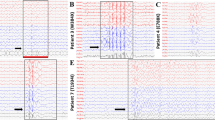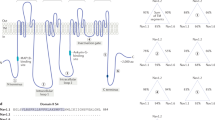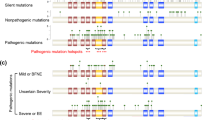Abstract
Inherited errors in ion channel genes comprise the largest subset of monogenic causes of idiopathic epilepsy, and pathogenic variants contribute to genetic risk in the complex inheritance of this common disorder. We generated a digenic mouse model of human idiopathic epilepsy by combining two epilepsy-associated ion channel mutations with mutually opposing excitability defects and overlapping subcellular localization. We found that increasing membrane excitability by removing Shaker-like K+ channels, which are encoded by the Kcna1 gene, masked the absence epilepsy caused by a P/Q-type Ca2+ channelopathy due to a missense mutation in the Cacna1a gene. Conversely, decreasing network excitability by impairing Cacna1a Ca2+-channel function attenuated limbic seizures and sudden death in Kcna1-null mice. We also identified intermediate excitability phenotypes at the network and axonal levels. Protective interactions between pathogenic ion channel variants may markedly alter the clinical expression of epilepsy, highlighting the need for comprehensive profiling of this candidate gene set to improve the accuracy of genetic risk assessment of this complex disease.
This is a preview of subscription content, access via your institution
Access options
Subscribe to this journal
Receive 12 print issues and online access
$209.00 per year
only $17.42 per issue
Buy this article
- Purchase on Springer Link
- Instant access to full article PDF
Prices may be subject to local taxes which are calculated during checkout





Similar content being viewed by others
References
Lander, E.S. & Schork, N.J. Genetic dissection of complex traits. Science 265, 2037–2048 (1994).
Badano, J.L. & Katsanis, N. Beyond Mendel: an evolving view of human genetic disease transmission. Nat. Rev. Genet. 3, 779–789 (2002).
Wallace, R.H. et al. Febrile seizures and generalized epilepsy associated with a mutation in the Na+-channel β1 subunit gene SCN1B. Nat. Genet. 19, 366–370 (1998).
Nadeau, J.H. & Topol, E. The genetics of health. Nat. Genet. 38, 1095–1098 (2006).
Gourfinkel-An, I. et al. Monogenic idiopathic epilepsies. Lancet Neurol. 3, 209–218 (2004).
Kearney, J.A. et al. Severe epilepsy resulting from genetic interaction between Scn2a and Kcnq2. Hum. Mol. Genet. 15, 1043–1048 (2006).
Pereira, S. et al. Severe epilepsy, retardation and dysmorphic features with a 2q deletion including SCN1A and SCN2A. Neurology 63, 191–192 (2004).
Smart, S.L. et al. Deletion of the K(V)1.1 potassium channel causes epilepsy in mice. Neuron 20, 809–819 (1998).
Liguori, R., Avoni, P., Baruzzi, A., Di Stasi, V. & Montagna, P. Familial continuous motor unit activity and epilepsy. Muscle Nerve 24, 630–633 (2001).
Zuberi, S.M. et al. A novel mutation in the human voltage-gated potassium channel gene (Kv1.1) associates with episodic ataxia type 1 and sometimes with partial epilepsy. Brain 122, 817–825 (1999).
Dodson, P.D. & Forsythe, I.D. Presynaptic K+ channels: electrifying regulators of synaptic terminal excitability. Trends Neurosci. 27, 210–217 (2004).
Tanouye, M.A., Ferrus, A. & Fujita, S.C. Abnormal action potentials associated with the Shaker complex locus of Drosophila. Proc. Natl. Acad. Sci. USA 78, 6548–6552 (1981).
Zhang, C.L., Messing, A. & Chiu, S.Y. Specific alteration of spontaneous GABAergic inhibition in cerebellar Purkinje cells in mice lacking the potassium channel Kv1. 1. J. Neurosci. 19, 2852–2864 (1999).
Noebels, J.L. & Sidman, R. Inherited epilepsy: spike-wave and focal motor seizures in the mutant mouse tottering. Science 204, 1334–1336 (1979).
Fletcher, C.F. et al. Absence epilepsy in tottering mutant mice is associated with calcium channel defects. Cell 87, 607–617 (1996).
Imbrici, P. et al. Dysfunction of the brain calcium channel CaV2.1 in absence epilepsy and episodic ataxia. Brain 127, 2682–2692 (2004).
Qian, J. & Noebels, J. Presynaptic Ca2+ influx at a mouse central synapse with Ca2+ channel subunit mutations. J. Neurosci. 20, 163–170 (2000).
Wang, H., Kunkel, D., Schwartzkroin, P. & Tempel, B. Localization of Kv1.1 and Kv1.2, two K channel proteins, to synaptic terminals, somata and dendrites in the mouse brain. J. Neurosci. 14, 4588–4599 (1994).
Noebels, J.L. & Rutecki, P. Altered hippocampal network excitability in the hypernoradrenergic mutant mouse tottering. Brain Res. 524, 225–230 (1990).
Lopantsev, V., Tempel, B. & Schwartzkroin, P. Hyperexcitability of CA3 pyramidal cells in mice lacking the potassium channel subunit Kv1.1. Epilepsia 44, 1506–1512 (2003).
Qian, J. & Saggau, P. Activity-dependent modulation of K+ currents at presynaptic terminals of mammalian central synapses. J. Physiol. (Lond.) 519, 427–437 (1999).
Dipple, K.M. & McCabe, E.R. Phenotypes of patients with “simple” Mendelian disorders are complex traits: thresholds, modifiers and systems dynamics. Am. J. Hum. Genet. 66, 1729–1735 (2000).
Dipple, K.M. & McCabe, E.R. Modifier genes convert “simple” Mendelian disorders to complex traits. Mol. Genet. Metab. 71, 43–50 (2000).
Brew, H.M., Hallows, J.L. & Tempel, B.L. Hyperexcitability and reduced low threshold potassium currents in auditory neurons of mice lacking the channel subunit Kv1.1. J. Physiol. (Lond.) 548, 1–20 (2003).
Zhou, Y.D., Turner, T.J. & Dunlap, K. Enhanced G protein–dependent modulation of excitatory synaptic transmission in the cerebellum of the Ca2+-channel mutant mouse, tottering. J. Physiol. (Lond.) 547, 497–507 (2003).
Acknowledgements
We thank I. Cohen for assistance with hippocampal experiments and data analysis, and D. Burgess, C. Davis, F. Deng, S. Ernst, W. Ernst, A. Goldman, M. Price and Y. Zhang for their critical input and guidance. This work was supported by US National Institute of Neurological Disorders and Stroke grants NS43124 (E.G.) and NS29709 (J.L.N.).
Author information
Authors and Affiliations
Contributions
E.G. carried out genetic crosses, genotyping, survival and behavioral analysis and recordings of evoked burst discharges. J.Q. performed the recordings of presynaptic fiber volley facilitation. J.W.Y. performed surgeries and recordings for electroencephalography, as well as drug injections. E.G. wrote the manuscript with assistance from J.L.N.
Corresponding author
Supplementary information
Supplementary Text and Figures
Supplementary Figures 1–3, Tables 1–3, Discussion and Note (PDF 1522 kb)
Rights and permissions
About this article
Cite this article
Glasscock, E., Qian, J., Yoo, J. et al. Masking epilepsy by combining two epilepsy genes. Nat Neurosci 10, 1554–1558 (2007). https://doi.org/10.1038/nn1999
Received:
Accepted:
Published:
Issue Date:
DOI: https://doi.org/10.1038/nn1999
This article is cited by
-
Gene–gene interaction network analysis indicates CNTN2 is a candidate gene for idiopathic generalized epilepsy
neurogenetics (2024)
-
Gene mutations in comorbidity of epilepsy and arrhythmia
Journal of Neurology (2023)
-
Clinical and molecular spectrum of P/Q type calcium channel Cav2.1 in epileptic patients
Orphanet Journal of Rare Diseases (2021)
-
Rare-variant collapsing analyses for complex traits: guidelines and applications
Nature Reviews Genetics (2019)
-
Pathway-driven discovery of epilepsy genes
Nature Neuroscience (2015)



